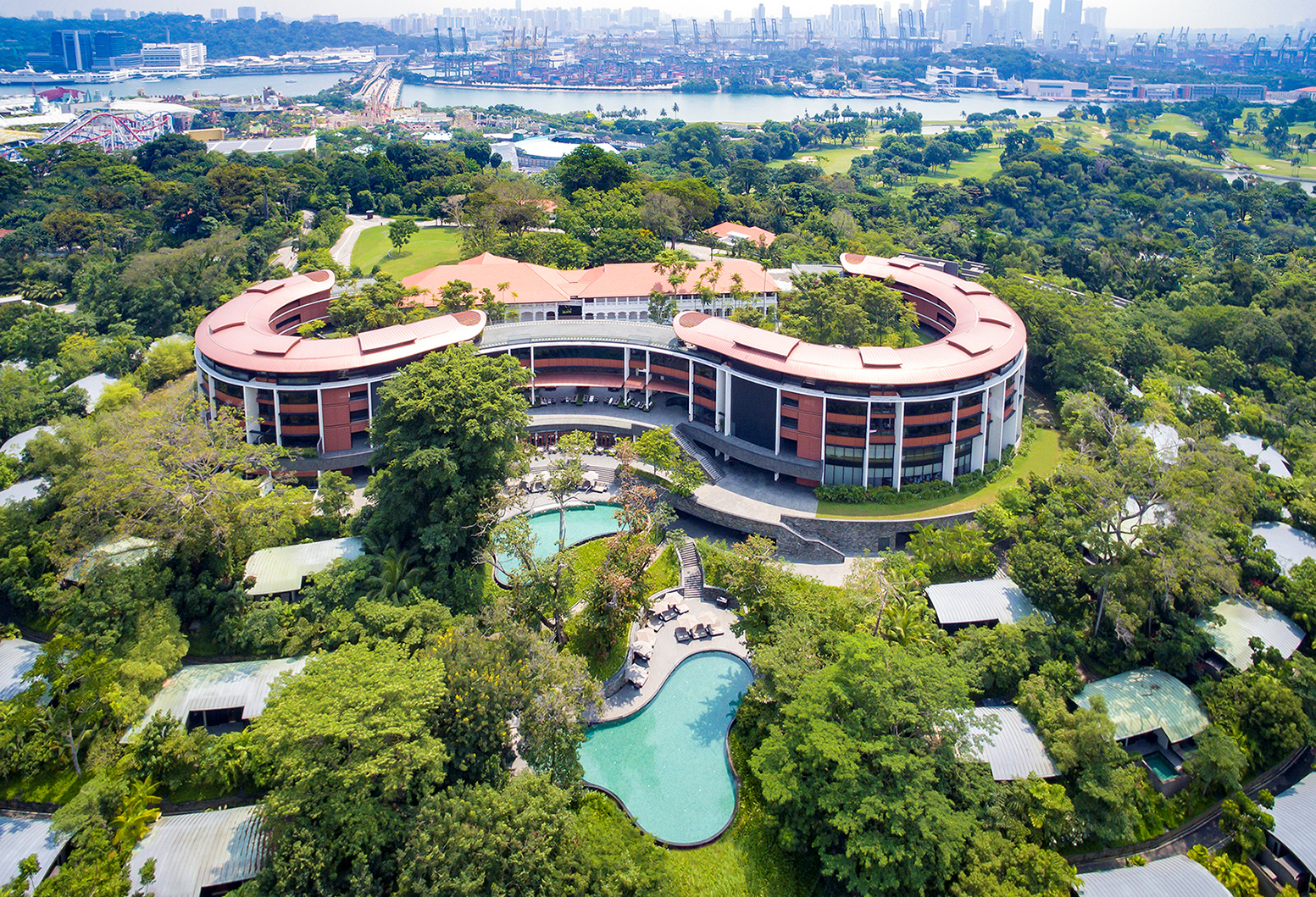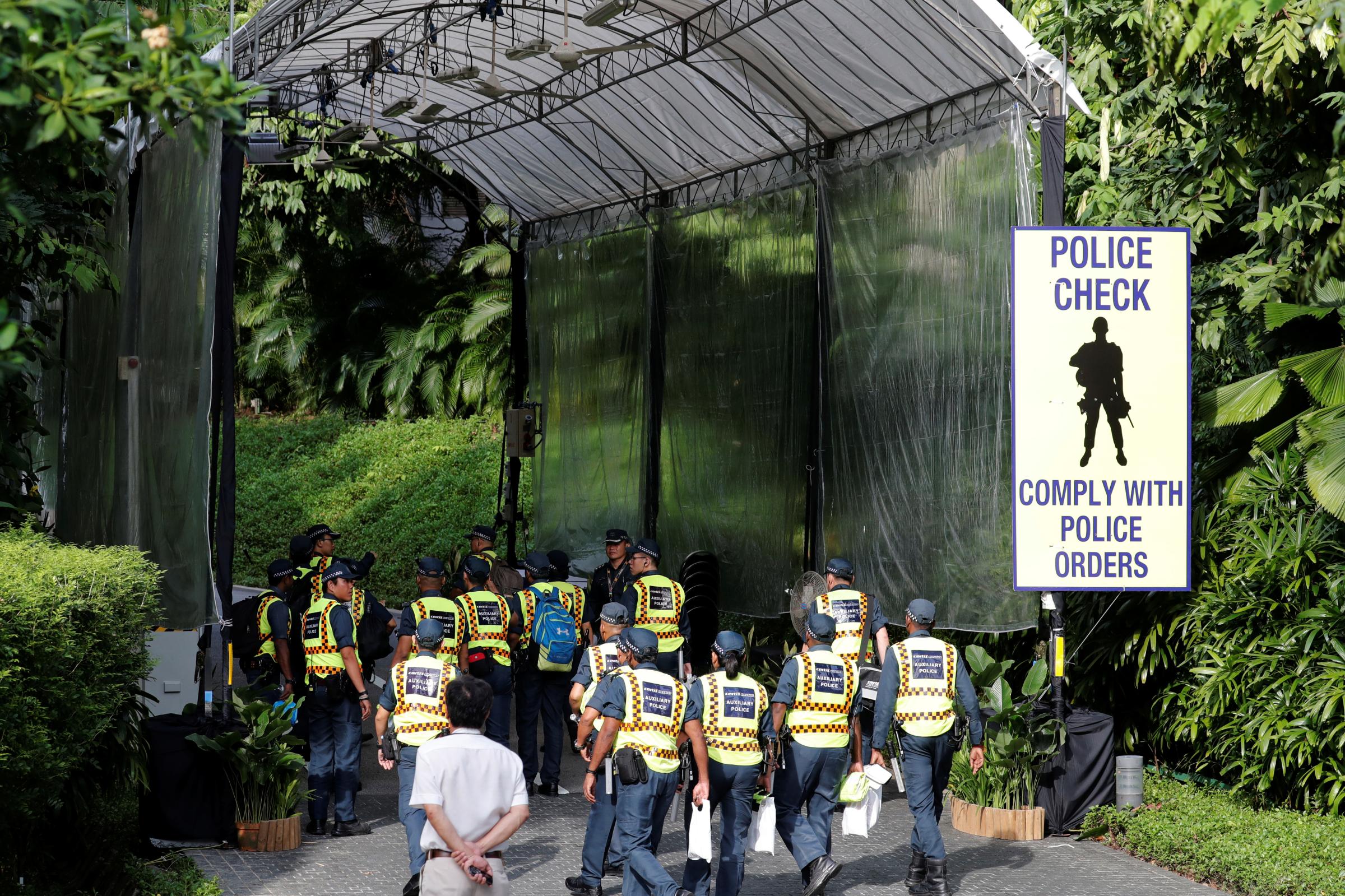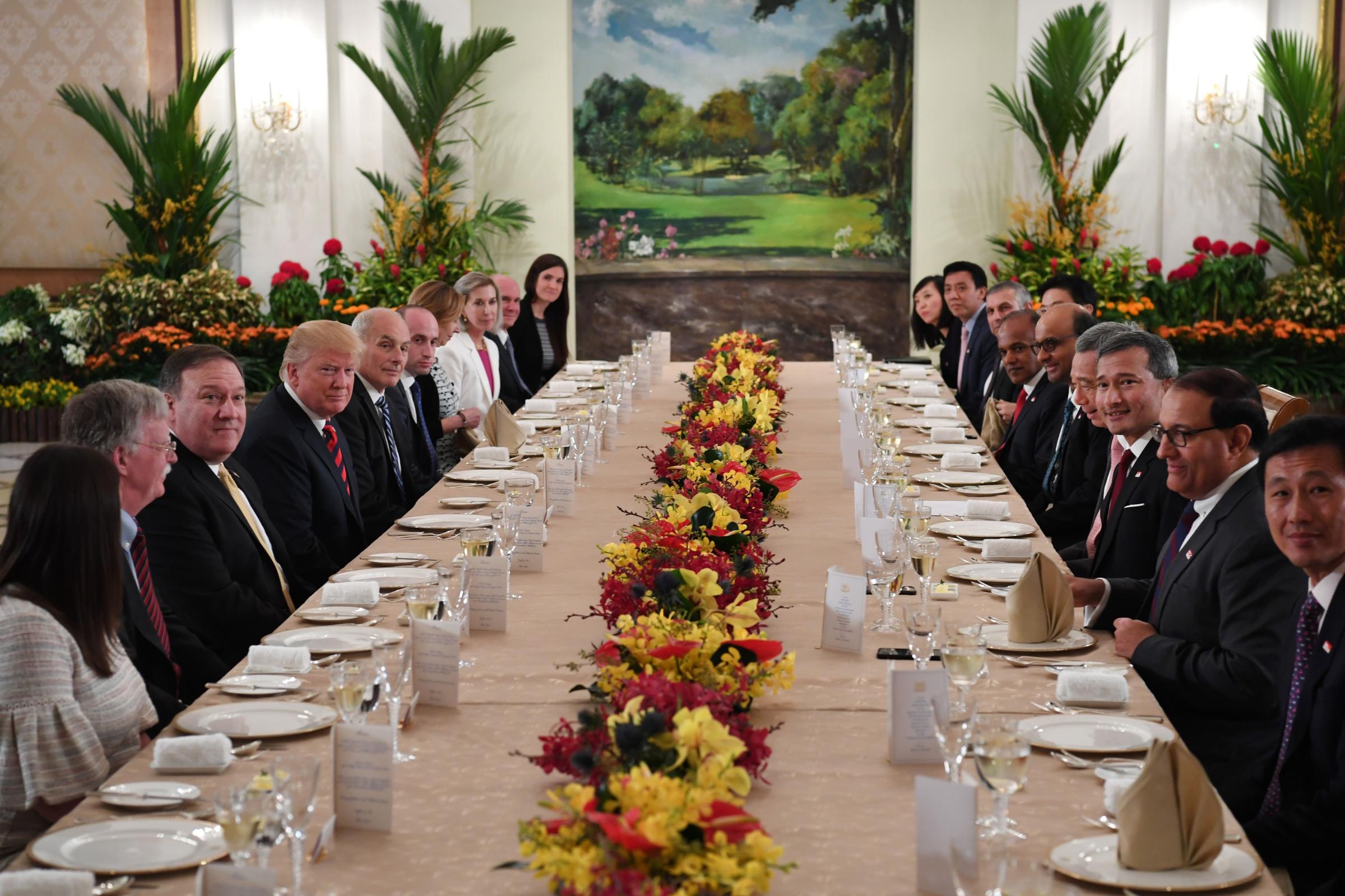The resort island of Sentosa is where Singapore’s most affluent patrons relax in cascades of pastels and khaki. Bronzed kids dance in water fountains, while their parents sip iced lager from beneath designer sunglasses. Sun-worshipers lounge on fake manicured beaches, gazing at a horizon filled with the container ships that turned this equatorial city-state of six million into Asia’s most prosperous trading hub.
Today, however, feels a little different. Snaking between the floating stacks of rectangular boxes, a gunmetal gray navy ship patrols the shoreline. Away from the imported Indonesian sand, dozens of riot police crowd around armored trucks, chatting intensely by gaudy murals of children screaming down a waterslide. Huge metal security fences are erected along sidewalks daubed with outsized yellow feet for guiding visitors to some of the 2 sq. mi. island’s 15 hotels and 30 tourist attractions.
“The leaders of America and [North] Korea are coming tomorrow,” says Sentosa gardener Mr Chiew, as he picks seaweed and trash from the beach’s tideline. “They need to talk.”
That they do. On Tuesday, U.S. President Donald Trump and North Korea’s Kim Jong Un will meet in Sentosa’s The Capella Hotel for the first ever summit between the leaders of these longtime adversaries. It’s a historic occasion spurred by Kim’s incredible advancement in nuclear capability since he came to power in 2011. His impoverished East Asian nation of 25 million has tested six nuclear bombs to date and now claims to have an intercontinental ballistic missile capable of delivering that apocalyptic payload to any American city.
Taming Kim has become Trump’s main foreign policy priority, which he’s attempted via a campaign of “maximum pressure” of three new rounds of strict U.N. sanctions, as well as threats of “fire and fury.” But now the dispute has taken a whiplash-inducing lurch toward negotiation. Tuesday’s powwow was brokered by liberal South Korean President Moon Jae-in, who has reached out to North Korea, the land his parent’s fled on a U.N. supply ship during the 1950-53 Korean War that cleaved the two nations apart.

A North Korean delegation attended the PyeongChang Winter Olympics and even fielded a unified Korean team in some events. Then Moon and Kim met for an historic summit at the peninsula’s demilitarized zone in April, and once again in May. South Korean officials then delivered Kim’s invitation for talks to Trump in the White House. “Moon Jae-ins mediatory role was crucial for the reconciliation between these historic archenemies,” says Cheong Seong-Chang, vice-president of research at South Korea’s Sejong Institute.
On Monday, North Korean state media floated the possibility that Pyongyang could “establish a new relationship” with the U.S. Trump has said he could even invite Kim to Washington. But rapprochement hinges on what happens at The Capella, where an airport-style X-ray scanner has been installed on the colonial pile’s stately white-washed porch. Police officers at security gates sweep incoming vehicles for bombs, as the tangled curls of the next-door Universal Studios rollercoaster loom overhead. But the hotel appears primed for good news: a stage with a television camera on a huge swinging “jib” has been erected on the front lawn, seemingly for a post-summit handshake photo opp.
But it’s unclear what Trump and Kim might announce. North Korea has indicated it would be willing to get rid of its nuclear arsenal if provided with a security guarantee from Washington. However, experts say that is unlikely given the effort expended to develop those weapons, which Kim sees as guaranteeing the survival of his dynastic regime. Even a deal to remove a number of bombs or classes of weapons would be a victory of sorts, though hawks in Washington, such as National Security Advisor John Bolton, say they would never accept anything less than complete, verifiable, and irreversible disarmament.

And so Tuesday’s meeting will likely just break the ice. According to reports, Trump and Kim will start their historic summit with a two-hour one-on-one session with translators, before an expanded bilateral meeting including advisers. One hope is that the two sides can agree a common definition of what “denuclearization of the Korean Peninsula” actually means. “I’m not sure we’re going to see a lot of progress on denuclearization at this upcoming summit,” a top U.S. diplomat tells TIME on condition of anonymity so he can speak candidly. “I suspect this will be the first in a long engagement process.”
This is unconventional, as typically lower-level officials with thrash out parameters in exhaustive meetings before the bigwigs swoop in for the declaration signing beneath the glare of photographers. But it is far from unprecedented. Communist China’s founder Mao Zedong met then U.S. President Richard Nixon in Beijing in 1972, but the two nations only normalized ties seven years later after extensive trust-building measures.
Read More: How Trump Decided to Meet Kim
“Especially for a state with whom we don’t have normal relations, it can be useful to start with a top-down summit that provides a mandate for lower level diplomats and negotiators to build up relations based on common interests,” Mintaro Oba, a former U.S. diplomat and West Wing speechwriter, told the Korea File podcast.
But even if Kim acquiesces to all American demands, full denuclearization could take 15 years to implement, according to a new report co-authored by Siegfried S. Hecker, a former director of the Los Alamos weapons laboratory in New Mexico, and one of the few Western scientists to have examined North Korea’s nuclear project.

That would require constant and consistent engagement with one of the world’s most repressive regimes for at least four more presidential terms. Given Trump’s recent nixing of U.S. involvement in the Iran nuclear deal, the prospect of American capriciousness will worry Kim. And signs are he is coming to Singapore to make a deal, given the marked shift North Korea seems to be making toward rapid development. “Kim Jong Un has made a bold, assertive decision that if he can get a security guarantee, North Korea will prioritize fast economic growth,” says the Sejong Institute’s Cheong.
If that is borne out, and Kim needed an example of “soft” authoritarianism done right, Singapore would be it. The city-state’s press and elections are tightly controlled, and even chewing gum is famously banned here. But the authorities prioritize social housing, jobs and education. It is consistently ranked among the world’s easiest places to do business.
“The entire world is watching the historic summit between [North Korea] and the United States of America, and thanks to your sincere efforts … we were able to complete the preparations for the historic summit,” a grinning Kim told Singapore Prime Minister Lee Hsien Loong soon after his arrival on Sunday. Let’s hope the smiles stay all week.
—With reporting by Stephen Kim/Seoul
More Must-Reads from TIME
- L.A. Fires Show Reality of 1.5°C of Warming
- How Canada Fell Out of Love With Trudeau
- Trump Is Treating the Globe Like a Monopoly Board
- Bad Bunny On Heartbreak and New Album
- 10 Boundaries Therapists Want You to Set in the New Year
- The Motivational Trick That Makes You Exercise Harder
- Nicole Kidman Is a Pure Pleasure to Watch in Babygirl
- Column: Jimmy Carter’s Global Legacy Was Moral Clarity
Write to Charlie Campbell / Sentosa, Singapore at charlie.campbell@time.com